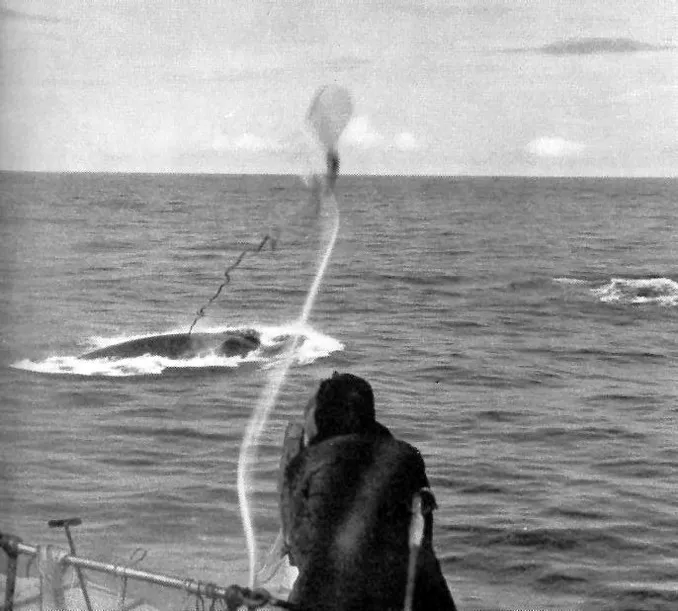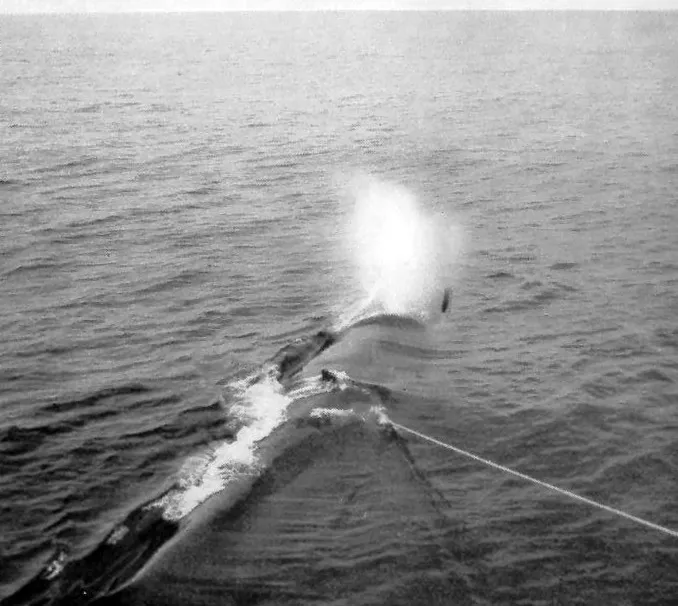Harpooning the Whale
Whales and Whaling pictures
Next
Previous
Back to gallery
Back to whale and whaling
thumbnails


With a steam (later diesel) powered whale catcher boat, coming up behind the whale was a much easier task than previously but still not so straightforward as might be assumed. The whale might dive for many minutes at a time and surface any where about, the engine speeding up to reach the whale would alert it and it may dive again, the process could and did often continue for many hours like this with no guarantee of being able to catch that particular whale.
But ultimately of course the odds were stacked greatly in the whalers favour and the whale was in the gunners sights and the harpoon released. The conditions shown here are close to ideal for the gunner with a virtually flat sea so neither the boat nor whale were rising and falling with the waves and little or no wind to make the sea surface choppy.
Despite the apparently huge target, it was not so easy to harpoon a baleen whale efficiently so as to ensure a rapid kill. The harpoon needed to hit the whale just behind the last rib so that it would go forwards into the body cavity and explode amongst the vital organs.
Too far forwards and it would hit a rib so causing it to explode on the surface of the whale, not an immediately fatal or debilitating blow and more crucially, not anchoring the whale with the harpoons flukes. Too far backwards and there was the possibility that the harpoon would shoot straight through the muscle mass leading to the tail and come out the other side, so attaching the whale boat to an agonized, but now enraged and barely debilitated whale. If the harpoon struck too far forwards and hit the skull, it would simply bounce off.
Very few whales were killed first time, over decades of whaling, the average number of harpoons it took to kill a baleen whale was 2.8.
There was danger for the whalers crew at this time too. Huge amounts of strong thick rope would play out as the whale sped off. Sometimes despite the enormous strength of the rope it snapped, the sudden release of many tons of force on a rope maybe 6 inches in diameter caused it to slash backwards to the boat. If an unfortunate crew member was caught by this rope it could easily smash bone and flesh to a pulp.
Sometimes the whale would not swim off forwards, but would dive and go sideways or backwards, the rope could get caught around the propeller or be fouled in some other way causing the rope to need to be cut. The only relatively safe way of cutting a rope under huge strain was to turn the boat so that the rope was turned partly around a bollard. Then a crew member - usually the gunner as he would be captain and had ultimate responsibility for the catcher boat - would cut the rope. This was accomplished by standing on the bollard and hitting the rope with as hard a blow as possible with the largest and sharpest axe available. All other crew were well out of the way of the flailing rope and the man who cut the rope was at the safe eye of the "storm".
This account of the killing
of a rorqual is taken from:
Villiers,
A. J. "Whaling in the Frozen South" 1925 - An account written
by a journalist of the very first factory ship expedition to
Antarctica by the Sir James Clark Ross in the 1923/24
season.
"At length, not a quarter of a mile from the mothership, a big bull rose to blow less than twenty yards away, directly in front of the waiting Star II's deadly gun. Captain Iversen, who seemed possessed of an intuitive knowledge of the movements of whales (hungry or otherwise) under water, had been long waiting, maneuvering his ship for this chance, and was standing ready on the little sparred platform behind the cruel gray gun. His left hand grasped the metal stock which swung the gun easily on its oiled bearings, and his right fore finger lightly clasped the trigger. Quietly and surely he took long and careful aim at the interminable gray flank turning before him. At last his fore finger twitched ever so slightly, and with a boom and a roar, a deluge of flying, twisted pads, a reek of explosive, the great shell-pointed steel harpoon flew out, and in a flurry of boiling foam the stricken leviathan sounded deep into the depths, in a terrible effort to rid himself of the burning steel. But his doom was sealed.
Despite the explosion in his body of the soft iron shell with which the harpoon is tipped, the great monster refused to die. As long as he could he remained below, struggling madly to free himself, but at length he was forced to the surface again for air. As he rose, the powerful winch on the Star II quickly hove in the harpoon line, and as his great back broke the surface of the sea the gun was loaded again and Captain Iversen, standing like a waiting matador, was ready to administer the death thrust. As the sorely wounded whale lay wallowing and struggling in the bloodstained foam the captain carefully trained his gun at the heaving target, and just as the bull turned in a vain effort to dive again, lifting half of his great bulk out of the water, the gun spoke once more and a second harpoon flew into the mountain of blubber and flesh. Instantly he sounded, the harpoon line running furiously over the bow-wheel. But not for long. The second shot had told, and scarcely two minutes later the great whale a mountain of death, suspended on the harpoon line fathoms below the gently rippling surface. And thus the first whale died.
Slowly we heaved it up to the surface, the little ship worked alongside, compressed air was pumped into the body, and a great chain passed around the small of its tail. Then with her prize tightly clasped to her cold steel side Star II slowly steamed to the mothership, and soon the white specked blue-gray body lay gently heaving in the slight swell fast alongside, the flukes of its tail cut off and two notches in what was left telling that two harpoons were required to dispatch this great monster of the sea.
